#snorri sturluson
Text

Olaf at London Bridge — English School (20th century)
#olaf#london#london bridge#england#viking age#anglo saxon#norway#norwegian#danes#ethelred the unready#snorri sturluson#heimskringla#history#art#drakkar#viking#vikings#middle ages#medieval#europe#olaf ii haraldsson#olav haraldsson#olaf haraldsson#ships#ship#sagas#nordic#norse#european
80 notes
·
View notes
Text
So I wrote an entire essay comparing Loki from The Bifrost Incident to Loki from the Prose Edda for my Medieval Literature Class, and I figured I'd post it here in case anyone wanted to read my analysis on her character
Essay Under Cut--(my formatting got fucked up by the hellsite but what can you do?)
“Is this truly me? What have I left behind?”
A look into how The Bifrost Incident interacts with its source material
Title from “Losing Track” by The Mechanisms
In the early 1200s, Snorri Sturlson wrote his famous collection of Norse mythology called The Prose Edda. In this compilation, we met many gods, goddesses, and creatures, including one who is arguably the most popular Norse deity--Loki, the god of mischief and general shenanigans. The Prose Edda presents Loki as dishonest, violent, at times incompetent. Recently though, about 800 years later, Loki has attracted the interest of many modern writers who have adapted Loki’s story to explore contemporary problems. One particular adaptation, The Bifrost Incident by English steampunk band The Mechanisms, imagines her to be just, intelligent, and loving. There are many striking differences between these two versions of Loki, the most significant being gender, mortality, and how their stories end. This is important because this album re-examines and redefines Loki’s identity, and how we view this Norse deity in a modern context.
To fully delve into how The Mechanisms’ adaptation works, I think some context for the band is necessary. The Mechanisms were an English steampunk band, self-described as “Storytelling Musical Cabaret'' that operated from 2010 until 2020. The Band members themselves were in character at all times as the immortal pirate crew of the Starship Aurora. They also took on the roles in the tales they told. So for example, Tim Ledsam was the guitarist for The Mechanisms, but when he was onstage he played Gunpowder Tim, Master at Arms on the Aurora, and when the band performed The Bifrost Incident, he voiced the character of Loki. The Mechanisms were best known for their clever reworking of mythologies, creating queer narratives and telling queer stories, and their love of tragedies. In their last concert (recorded as a live album), Death to The Mechanisms, Jonny D’ville--the band’s first mate/lead vocalist. played by Jonny Sims--and Ashes O'Reilly--the band’s quartermaster/bassist, played by Frank Voss--had a conversation that encapsulates the crew's relationship with unhappy endings:
[Jonny]
"We happen to stumble across tragic situations where everyone dies. I mean, obviously there are stories where people live but we just choose not to tell them."
[Ashes]
"Yeah, 'cause they're boring."
[Jonny]
"Yeah…”
The fact that this conversation happened during some technical difficulties in the song “Terminus”, the finale of The Bifrost Incident where the entire star system is consumed by a Lovecraftian Cosmic Horror, only adds credence to their claims.
With that bit of explanation out of the way, let’s discuss the similarities between Sturlson’s work and The Mechanisms’ adaptation of it. Loki from The Prose Edda and Loki from The Bifrost Incident share many important similarities. These similarities are important because they make the character recognizable, giving us a reference point and allowing the audience to connect the new version to the original. The Mechanisms play on the audience’s knowledge of Norse Mythology, creating an insider audience. Listeners feel like they are in on the joke, as they understand what myths or details are being referenced. The Mechanisms also use these similarities to create puns, as they often do in their albums. For example, in The Prose Edda Baldur is killed by Mistletoe, and in The Bifrost Incident Loki kills Baldur with Missile 2 (the second missile).
Another thing The Mechanisms’ adaptation has in common with Sturlson’s work is how they develop ideas through music. The Bifrost Incident is a musical album, with each song continuing the story, much like the soundtrack to a musical. It alternates between spoken narration and songs, weaving music into the fabric of the tale. The Prose Edda does this as well! We have evidence that the original myths were probably put to music, connecting this modern work to its source.
This being said, there are significant differences between the Loki of The Prose Edda and the Loki from The Bifrost Incident. I’ve selected just three to discuss at this time, the ones I think are the most important. The first is gender. In The Prose Edda Loki and Odin are firmly male, using exclusively male pronouns. There is a specific instance in the text where Loki turns into a mare and gives birth to Sleipnir, Odin’s eight-legged steed. This is seen in a negative context, as a way to shame or punish Loki. In The Bifrost Incident, however, Loki and Odin are gender-bent, using exclusively female pronouns. Loki’s gender expression in the album is further complicated by how her character is voiced. Gunpowder Tim, who as far as I can tell is a cisgender man, voices this specifically female character. The use of a more masculine-sounding voice actor for a character that not only uses feminine terms and pronouns but also is married to another woman in the album introduces a new, interesting layer of queerness to the narrative. Because of this casting decision, it’s a commonly held belief among fans that Loki is a trans woman in the album. These choices help the audience explore modern queer themes through the lens of Norse mythology. And it creates a contrast to how gender, sexuality, and queerness in general, were talked about in Snorri Sturlson’s time.
The second difference I’d like to discuss is Loki’s mortality (or lack thereof). In The Prose Edda Loki is a god, an immortal being that could affect the world around him and cause problems on large scales. This allows many myths to happen, most strikingly the ones where Loki transforms into an animal to either cause problems or fix a problem he caused. Now this is complicated by the fact that Snorri Sturlson did not believe the characters in the myths he was compiling were gods. He lived in a Christianized world, trying to compile stories to save them for poets. Either way, Prose Edda Loki is an immortal deity. But in The Bifrost Incident, it is important that all our characters are mortal. It intensifies the tragedy of Loki and Sigyn, their sacrifice and Odin’s demise. It helps us relate to the characters in a way that we don’t get if they’re immortal. In the narration “Cold Case”, we learn that Loki was thought to be dead, and in the song “Sigyn” we get the heartbreaking reunion between Loki and her wife, Sigyn. But the reason I cry every time I listen to “Sigyn” is because of how heartrendingly happy Sigyn is to see her wife, alive and in front of her, and then see that relief ripped away as she realizes that Loki doesn’t recognize her. The humanity, the fear and permanence of death, of losing those you love, is one that we as an audience can easily relate to.
My final difference, and possibly the most important difference, is the ending to Loki’s story. After killing Baldur in The Prose Edda, Loki is chased down by the Aesir and eternally punished: He is imprisoned below the earth, tied down with the entrails of his sons, and has a snake set above him to drip poison into his eyes. His wife, Sigyn, stays with him by choice, holding a cup above him to catch the venom, but the vessel can only hold so much before it must be emptied. So when Sigyn has to empty the cup the venom gets into his eyes, and his thrashing is the etiological myth for why earthquakes happen. Eventually, Loki is destined to escape and kick off Ragnarok (the end of the world), where he fights against the Aesir--sailing in on Naglfar and fatally injuring Heimdall before dying himself. These all add up to an ultimately evil view of Loki, even if he is a bit sympathetic. He turns against the gods and his children are the cause of much destruction. However, the Loki of The Bifrost Incident has a completely different characterization. After her memories are returned to her, she leaves Odin to her madness and goes to find Sigyn. She tells Sigyn what they must do to delay the eldritch train as long as possible, keeping the end of the world from happening for 80 years--
“They uncouple the [train] carriages behind [them] and Loki lays upon the altar. Sigyn pushes a single line into her wife's heart and holds it tight. All she lets through is a drip drip drip, flowing through the glyphs and gears. When Loki's heartsblood is gone, the train will arrive, but until then, they are together.”
Loki chooses to sacrifice herself to stop the end of all life in her star system. This is almost directly opposite of how Loki acts in The Prose Edda. She is noble, in contrast to his cowardice.
I think it’s important to consider why these changes were made. Some are more obvious--The Mechanisms always committed to the bit at full throttle. It’s evident from their stage presences that they cared about the storytelling more than anything else. So many of the more minor changes are to keep to the aesthetic choices the band made--setting it in space, steampunk and cyberpunk imagery, and the puns we talked about earlier. Some choices were made to turn the original myths into queer stories. Making Loki and Sigyn a lesbian couple, as well as having Loki use feminine terms and pronouns while being voiced by a traditionally masculine voice actor, fall into The Mechanisms’ commitment to telling queer stories. Many of the band members themselves are queer, and the vast majority of their fanbase identifies as LGBTQ+. And finally, The Mechanisms only tell tragedies. We discussed this at a few earlier points, how the change from god to mortal fed into the tragedy of the story they were trying to tell.
So why does this matter? Why should we care about a Steampunk concept album written in 2017 that no one has ever heard of? The Prose Edda was written to preserve poetry, religion, mythology, and meaning post-Christianization. Why was The Bifrost Incident written? I believe that it’s a commentary on corrupt government systems, as seen with Odin, as well as a cautionary tale about the dangers of pushing too far without the proper safety precautions. It’s also just a fun retelling of myths that most are fairly familiar with in a fun, new setting we never would have expected. The Bifrost Incident takes stories written hundreds of years ago and creates a modern narrative that is as enjoyable as it is thought-provoking. And I hope this paper, if nothing else, convinces you to listen to the Album.
#Loki#norse mythology#the mechanisms#the bifrost incident#loki tbi#tbi loki#The Prose Edda#the mechs#snorri sturluson
139 notes
·
View notes
Text
In Honor of my Nordic Literature, History, Geography, and Linguistics exam on Thursday. Here are some of the books I read so far:
Henrik Ibsen - A Doll's House (1879) Although this is a theater play. I really loved it to be honest with you. It felt very contemporary despite being set in the 19th century. It's the definition of a humanist play/novel.
Jonas Gardell - Don't Ever Wipe Tears Without Gloves (2012-2013) This book is made up of a series called Love, Disease, and Death. It was very emotional and beautiful. It reminded me a lot of a TV show called ''It's A Sin'' or ''Pose''
Henning Mankell - Faceless Killers (1991) They say that Swedish crime fiction is the best in the world and they didn't lie. This book was very intense, sad, and well done in my opinion.
Pär Lagerkvist - The Dwarf (1946) Set in my home country, the book really analyses hate in a very deep way. It was definitely a great reading for sure
Selma Lagerlöf - The Wonderful Adventures of Nils (1906) This other book was another great discovery. It's really beautiful and it kinda reminded me of Pinocchio a bit. I loved it honestly
Karin Boye-Kallocaina (1940) Published at the beginning of World War II, this book really focuses on the horrors of authoritarian regimes. I guess this book was the inspiration for George Orwell's 1984
Ludvig Holberg - Niels Klim's Underground Travels (1741) This other reading was really good as well. The plot was very reminiscent of an underground Robinson Crusoe. However, I think this other book was the inspiration for Jules Verne's novel
Snorri Sturluson - Prose Edda (Early 12th Century) This one is a must. If you're interested in Scandinavian Literature and Cultures, this one is the best choice. This book has a mixture of Christian elements but mostly Norse mythology. This is the book where all the Norse myths come from.
The exam will be on Thursday. I hope it goes well !!

#literature#sweden#denmark#norway#scandinavia#scandinavian literature#iceland#norse mythology#lgbt literature#mythology#books#henrik ibsen#snorri sturluson#Ludvig holdberg
21 notes
·
View notes
Text
Just found out that Snorri Sturluson, author of the prose edda, thinks that five is an acceptable number of kennings but any more than that is too much. Which is hilarious because in my completely objective factual opinion, two kennings is really pushing it. Once you've hit three, you might as well stop worrying. It's like murders. One murder I can just about see being justified, two it's hard to imagine why that would come up, and meanwhile Snorri over here is going "I know I've killed five people but this guy over here has killed NINE, so watch out for him!!"
10 notes
·
View notes
Text

Odin, the All-Father
I know that I hung
on the wind-swept tree
all nine nights
with spear was I wounded
and given to Odin,
myself to me,
on that tree which no one knows
from which roots it grows.
Bread I was not given,
no drink from the horn,
downwards I glared;
up I pulled the runes,
screaming I took them,
from there I fell back again.
- excerpt from Sturluson's Prose Edda.
#odin allfather#odin#the allfather#the wanderer#aesir#norse runes#ai community#snorri sturluson#prose edda#norse mythology#norse pagan witch#norse pantheon#norse paganism#pagan stuff#pagans of tumblr#witchblr
7 notes
·
View notes
Text
Heilsa!
Book I am reading early this morning is, The Poetic Edda by Snorri Sturluson, translated by Carolyne Larrington. I've read other translations as well; Jackson Crawford and also Lee Hollander, which aren't bad in any way, but so far I'm really enjoying Larrington's version. I recommend 💯 this read to all my fellow heathens because this version is very easy to follow, has both Old Norse and English translations.
“godt nytt år!” (Happy New Year)
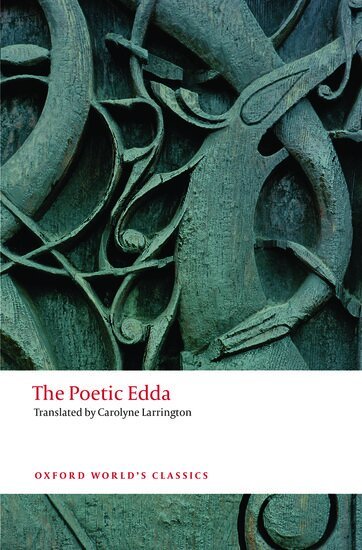
#norse#heathen#pagan#paganism#Snorri Sturluson#the poetic edda#norsegods#norse myths#codex regius#asatru#norsepagan#norse paganism#heathenry#heathenism#stories#poems#Kennings#edda#skaldic poetry#norse culture#literature#philosophy#old gods#icelandic#iceland#scandinavia#norse mythology#norse folklore#norse gods#mythology
37 notes
·
View notes
Text
Sonatorrek - Egil Skallagrimsson, from Egil's Saga, by Snorri Sturluson
1. My tongue is sluggish
For me to move
My poem’s scales
Ponderous to raise
The god’s prize
Is beyond my grasp
Tough to drag out
From my mind’s haunts
2. Since heavy sobbing
Is the cause -
How hard to pour forth
From the mind’s root t
He prize that Frigg’s
Progeny found
Borne of old
From the world of giants
3. unflawed, which Bragi
Inspired with life
On the craft
Of the watcher-dwarf
Blood surges
From the giant’s wounded neck
Crashes on the death-dwarf’s
Boathouse door
4. My stock
Stands on the brink
Pounded as planar-trees
On the forest’s rim
No man is glad
Who carries the bones
Of his dead kinsman
Out of the bed
5. Yet I shall
First recount
My father’s death
And mother’s loss
Carry from my word-shrine
The timber that I build
My poem from
Leafed with language
6. Harsh was the rift
That the wave hewed
In the wall
Of my father’s kin;
I know it stands
Unfilled and open
My son’s breach
That the sea wrought
7. The sea-goddess
Has ruffled me
Stripped me bare
Of my loved ones:
The ocean severed
My family’s bonds
The tight knot
That ties me down
8. If by sword I might
Avenge that deed
The brewer of waves
Would meet his end;
Smite the wind’s brother
That dashes the bay
Do battle against
The sea-god’s wife
9. Yet I felt
I lacked the might
To seek justice against
The killer of ships
For it is clear
To all eyes
How an old man
Lacks helpers
10. The sea has robbed
Me of much
My kinsmen’s deaths
Are harsh to tell
After the shield
Of my family
Retreated down
The god’s joyful road
11. Myself I know
That in my son
Grew the makings
Of a worthy man
Had that shield-tree
Reached manhood
Then earned the claim
Of war’s arms
12. Always he prized
His father’s words
Highest of all, though
The world said different
He shored me up
Defended me
Lent my strength
The most support
13. My lack of brothers
Often enters my thoughts
Where the winds
Of moon-bears rage
I think of the other
As the battle grows
Scout around
And wonder justification
14. which other valiant
Warrior stands
By my side
In the peril;
I often need him
When facing foes
When friends dwindle
I am wary to soar
15. It is rare to find
One to trust
Amongst men who dwell
Beneath Odin’s gallows
For the dark-minded
Destroyer of kin
Swaps his brother’s
Death for treasure
16. [Excluded. Missing, incomplete verse.]
17. It is also said
That no one regains
His son’s worth
Without bearing
Another offspring
That other men
Hold in esteem
As his brother’s match
18. I do not relish
The company of men
Though each of them might
Live in peace with me;
My wife’s son
Has come in search
Of friendship
To One-Eye’s hall
19. But the lord of the sea
Brewer of storms
Seems to oppose me
His mind set
I cannot hold
My head upright
The ground of my face
My thoughts’ steed
20. ever since the raging
Surf of heat
Snatched from the world
That son of mine
Whom I knew
To shun disgrace
Avoid words
Of ill repute
21. I remember still
When the Gauts’ friend
Raised high
To the gods’ world
The ash that grew
From my stock
The tree bearing
My wife’s kin
22. I was in league
With the lord of spears
Pledged myself loyal
To believe in him
Before he broke off
His friendship with me
The guardian of chariots
Architect of victory
23. I do not worship
Vilir’s brother
Guardian of the gods
Through my own longing
Though in good ways too
The friend of wisdom
Has granted me
Redress for affliction
24. He who does battle
And tackles the hell-wolf
Gave me the craft
That is beyond reproach
And the nature
That I could reveal
Those who plotted against me
As my true enemies
25. Now my course is tough:
Death, close sister
Of Odin’s enemy
Stands on the ness:
With resolution
And without remorse
I shall gladly
Await my own
2 notes
·
View notes
Text
My friend went to Iceland and she brought this back for me:
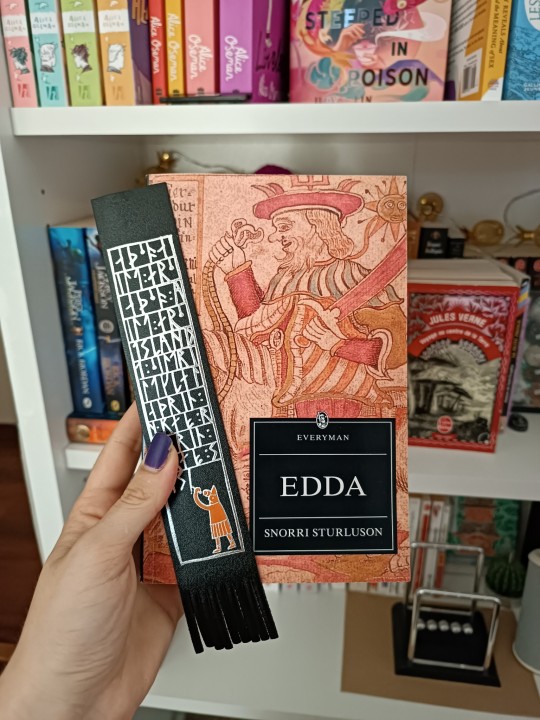
The Edda is one of the pillars of Icelandic literature and contains "the most extensive account of Norse myths and legends that has survived from the Middle Ages" (from the back cover).
I've never read anything like this (aside from simplified versions of Chrétien de Troyes as a kid maybe), but I love mythology and I've always wanted to read about Norse myths. Hope I like it!
Mon amie m'a ramené un souvenir d'Islande:
Edda est un des piliers de la littérature islandaise et contient "le récit le plus complet des mythes et légendes nordiques qui nous soit parvenu du Moyen Âge" (d'après la quatrième de couverture).
Je n'ai jamais rien lu de semblable (à part peut-être des versions simplifiées de Chrétien de Troyes quand j'étais petite), mais j'adore la mythologie et j'ai toujours voulu en savoir plus sur les mythes nordiques. J'espère que je vais aimer !
#did you see what i did#with jules verne#i put journey to the center of the earth in front for the pictures#because they start the journey in Iceland#get it#hehe#i'm so smart#icelandic literature#iceland#edda#the edda#snorri sturluson#books#classics#classic literature#booklr#french
74 notes
·
View notes
Text
I hate the “Ragnarök is a Post-Christian Myth” theory.
First off, it feels like most people see that Snorri Sturluson was Christian and immediately assume he did what the Irish monks did to Irish mythology. This completely ignores why he wrote the myths down, which was to establish a cultural connection between Iceland and Norway, in order to try and get Iceland to join the Kingdom of Norway (which failed). It also ignores that fact that he WASN’T A MONK. Outside of a part about the Aesir being Trojans and living in Asia (which makes no sense when looking at the rest of the Edda and the myths within), and some stuff about some great god who is more powerful than all of the Aesir and is never actually named, there isn’t much evidence to there being large post-Christian changes.
The second problem is that the theory focuses too much on Loki. He doesn’t do much during Ragnarök. He captains a ship (whatever that meant to the Norse) and he kills/dies to Heimdallr. Each of his kids from Angrboda does more. Fenrir eats Odin, and in some versions also the sun, moon, and stars. Jormungandr floods Midgard and poisons the sky, along with killing the strongest of the Aesir, Thor. Hel(a) brings an army of Draugr from her realm to fight Odin and Freya’s einherjar (Freya got half of those who died in battle). I agree that Ragnarök is a story of revenge, but its not Loki’s. ITS THE JOTNAR’S REVENGE. Revenge for a long list of insults and grievances that started with the killing of Ymir during the Voluspa by Odin and his brothers. Also, both Fenrir and Jormungandr are getting revenge against the gods they hate most, whom they are stated to kill. In the end Surtr, king of Muspelheim, kills Freyr, destroys Asgard, and burns all of the worlds (which since they are made of Ymir’s corpse, make this technically Ymir’s funeral pyre). Also the Jotnar on Loki’s ship aren’t his troops, they are led by a different Jotun, and it isn’t even his ship.
I could do an entire other post on the problems with how Loki gets viewed through modern lenses, and I’m tempted to.
#norse gods#norse#norse loki#norse mythology#odin#thor#snorri sturluson#poetic edda#vikings#viking#aesir#ragnarok#loki#norse thor#norse odin#fenrir#surtr#jormundgandr#hel#hela#asgard
9 notes
·
View notes
Text
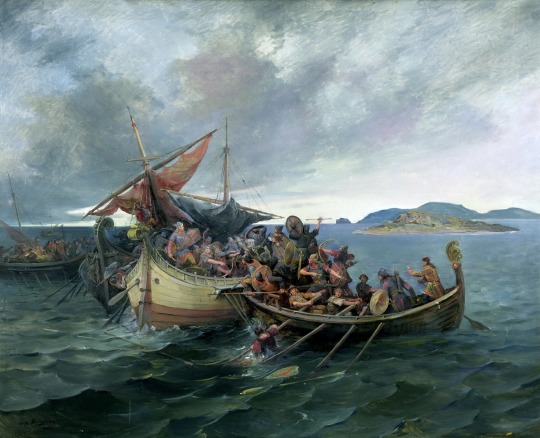
The Battle of Svolder by Nils Bergslien
#battle of svolder#art#nils bergslien#jomvikings#viking age#baltic sea#norway#denmark#sweden#old norse#kings sagas#snorri sturluson#viking#medieval#warships#ships#vikings#scandinavia#europe#northern europe#nordic#norse#germanic#heimskringla#norwegian#danish#swedish#sagas#kings#naval battle
82 notes
·
View notes
Text
Baylan Skoll and Shin Hati and literary symbolism
Ahsoka has its pros and cons, but I just looked up Skoll and Hati from Norse mythology again, and I think that they were trying to set up something cool and potentially literary that unfortunately didn't really get resolved on screen before the tragic death of Ray Stevenson.
Skoll is the wolf that chases the sun, the source of all warmth and power and vitality, and Baylan is trying to find some ineffable origin or beginning of the Force, the source of the cycle of the Jedi and the Sith, etc. so he's metaphorically going after the sun of the world of Star Wars.
That leaves Hati, who is the wolf that chases the moon, and trying to shoot the moon is idiomatically any act of brazen ambition or foolhardy efforts to achieve the impossible, and Baylan parted ways with Shin because he perceived that her goals were more about ambition and didn't line up with his absurd mystic quest, and it's a bit of wet kazoo sound moment at the last episode, but she emerges from the wilderness of Peridea ready to seize control of that bandit community and be a warlord, maybe strive to conquer the planet, I don't know. Ambition!
Is this anything?
2 notes
·
View notes
Text
Episode 13: Maja Bäckvall on the Prose Edda, funky Norse illustrations, and the MCU Thor movies
Uppsala-Eddan, p. 47, Skaldic lists with figures dancing (?) in the margins.
In Episode 13 of Inside My Favorite Manuscript, Lindsey and Dot chat with Maja Bäckvall about Uppsala University DG 11, one of four surviving copies of the so-called Prose Edda written by Snorri Sturluson in the 1220s. The Uppsala copy was made in Iceland in the first quarter of the 14th century. We talk about what exactly the Prose Edda is, how this copy differs from the others, we look at the illustrations, and we also make Maja talk about THOR (the movies from the Marvel Cinematic Universe).
Listen here, or wherever you find your podcasts.
Below the cut are more page images and links to the shows and books we mention during our conversation.
Uppsala-Eddan, Uppsala University Library DG 11 (digitized on the Alvin portal)
Uppsala-Eddan, p. 50

Close-up on p. 50 - see the man's name written over his head (also there's a little hole in the parchment on the right, with the text from the page before visible through it)
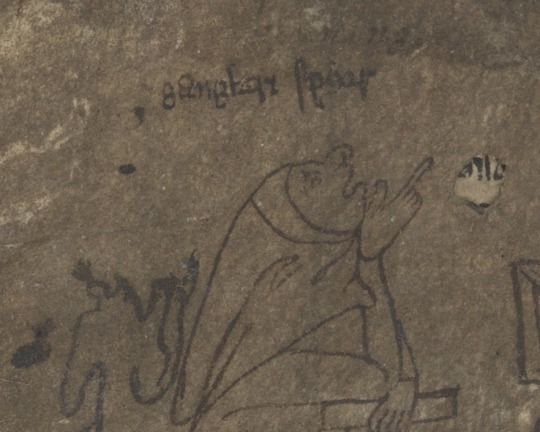
Another close-up on p. 50, where a later artist (or wishes-to-be-an-artist) is trying their hand at drawing their own king.

Uppsala-Eddan, p. 49 (the other side of p. 50), with illustration of a woman added to the manuscript in the 15th century:

Uppsala-Eddan, p. 47, Skaldic lists with figures dancing (?) in the margins.

Uppsala-Eddan, p. 42. The bottom portion of the page was left blank and filled in later, with text written upside-down. The staining may be from a chemical reagent used to bring out faded ink.
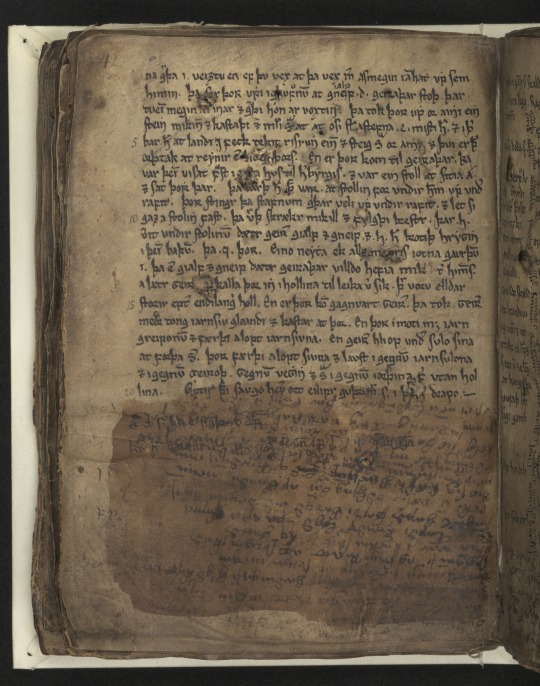
Uppsala-Eddan, p. 42, a close-up of the bottom of the page, reversed so the text is right-side-up

Uppsala-Eddan, p. 43, where the upside-down text continues in the bottom margin.
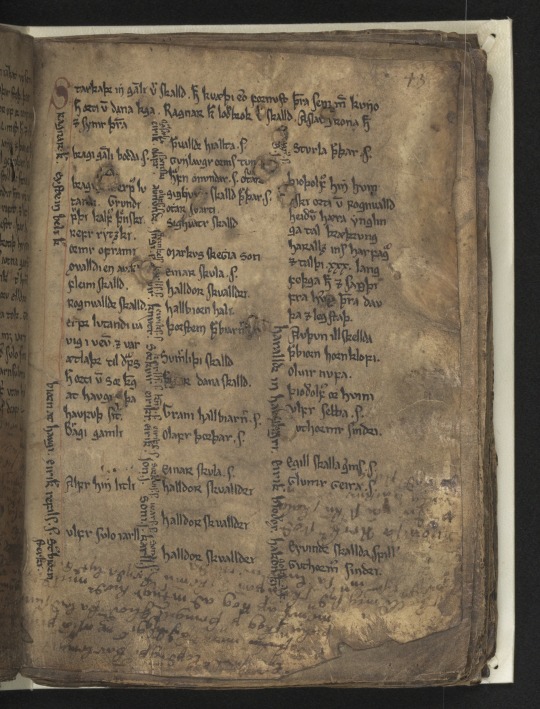
Uppsala-Eddan, p. 43, bottom margin reversed and cropped

Uppsala-Eddan, front flyleaf recto (original parchment with text and illustration added later)
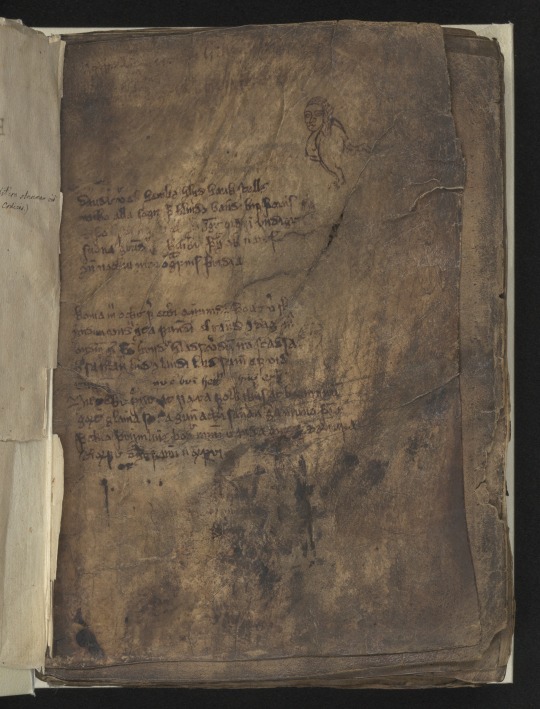
Uppsala-Eddan, p. 1, close-up of "sphinx-like creature" (I'm not really sure what that is!)

Uppsala-Eddan, front flyleaf verso with Bishop drawn in after the original text was written, probably at the same time as the text written on the recto side of the leaf
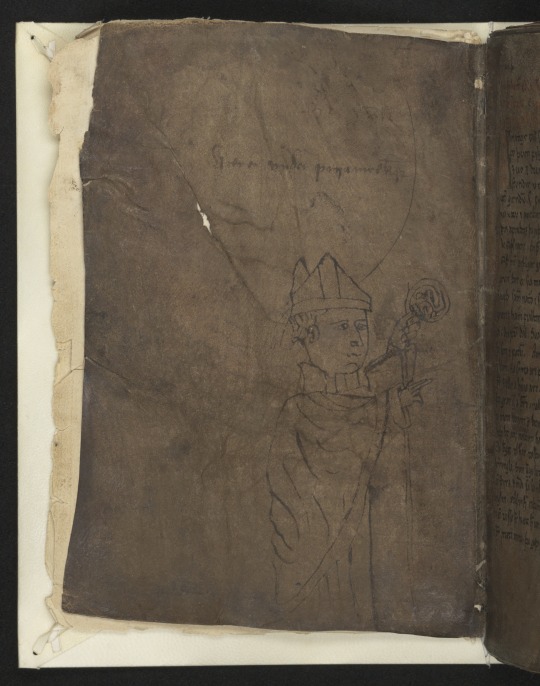
Uppsala-Eddan, p. 1, the first page of the Edda text.

Uppsala-Eddan, p. 1, a close-up at the text in red at the top of the page, which names the text as Edda and the author as Snorri Sturluson (both underlined)

Uppsala-Eddan, p. 1, close-up of the initial, which is quite fancy for an Icelandic manuscript

Thor movies in the MCU (IMDB)
Vikings TV show (IMDB)
The Northman (Dir. Robert Eggers, 2022) (IMDB)
πορφυρογέννητη, a fan fiction by neonheartbeat (posted with permission from the author)
Travel Light by Naomi Mitchison (book on Goodreads)
#medieval#manuscript#podcast#old norse#icelandic#icelandic manuscript#snorri sturluson#prose edda#skaldic poetry#vikings#thor#imfm#imfmpod
6 notes
·
View notes
Text

O radiator, we're really in it now...
8 notes
·
View notes
Text

It’s taken 1000 years of toil but thanks to Night of the Day of the Dawn of the Son of the Bride of the Return of the Revenge of the Terror of the Attack of the Evil, Mutant, Alien, Flesh Eating, Hellbound, Zombified Living Dead Part 2 (a film, whose title means “warrior”) we have reached kenning levels so lethal they would kill Snorri Sturluson dead
6 notes
·
View notes
Text
I have a question (it’s more like thought dump, but still).
I’ve been meaning to talk about this for monthsss 🤦🏻
So, Angrboda’s name of course means “the one who brings grief” in Old Norse - or at least it’s the general meaning that has been retained.
Now, I’ve been reading a Loki fiction series by C. Gockel, and (don’t worry I’m not giving spoilers for anything in the books) Angrboda’s name in the series is actually “Anganboda”, which according to its etymology in both Icelandic and Old Norse, means “pleasant/sweet odor”. https://en.wiktionary.org/wiki/angan
In the series, Loki is talking to a human about “Anganboda” and says something along the lines of, “Your scholars gave her the wrong name.”
Another translation I found to “Angan” in Old Norse is “delight, joy”. https://skaldic.abdn.ac.uk/m.php?p=onwword&i=4244 which is the translation that Loki uses in the series.
So my question is this: Have any of you in your UPG or even in the area you live (i.e. cultural stories/common local mythology) experienced Angrboda with an alternative name such as this?
I can’t help but think of how Loki and his family were demonized by Snorri in writing and smeared his name for centuries then-on. What else was smeared? Could Angrboda’s name been purposefully translated as such because of Christian influence from Snorri and the possible way in which he saw her association with Loki? What if her name never actually meant “bringer of grief, bringer of sorrow” before Snorri’s time?
Just some thoughts I meant to have shared since late last year and never got around to until now lol.
#angrboda#norse mythology#upg#norse gods#norse loki#snorri sturluson#etymology#norse paganism#thought dump
2 notes
·
View notes
Text
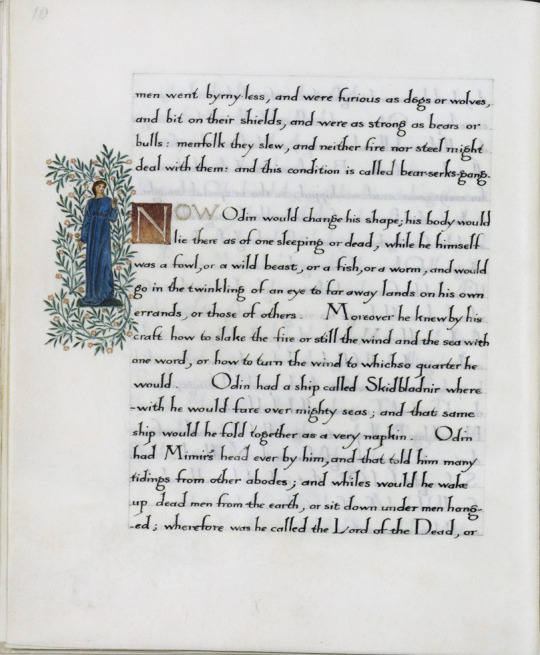
The Story of the Ynglings - translated from Icelandic & designed by William Morris 1872?
5 notes
·
View notes